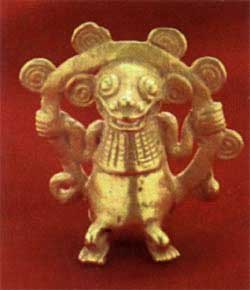Gold Bell Pendant in the Form of a Monkey, 500 CE - 1550 CE
Gold
1.5
PF.4111
Spanish chronicles of the 17th Century vividly describe finding tombs where chiefs, warriors and elite personages were literally covered in gold ornaments. Gold clothing was believed to symbolize the celestial...
Spanish chronicles of the 17th Century vividly describe finding tombs where chiefs, warriors and elite personages were literally covered in gold ornaments. Gold clothing was believed to symbolize the celestial realm, particularly the sun, as the life-giving energy source of the world. For the ancient Costa Ricans gold meant nothing until it was fashioned into a work of art. Then, it not only acquired meaning, but also power in possessing a supernatural energy gleaned from the artist's skill, and his intent to communicate ideas of his people's religious beliefs. The iconography of Costa Rican jewelry was strictly controlled and though the artists delighted in depicting a variety of animals, only certain ones were portrayed. Monkeys were a favorite theme due to their natural appeal and importance to Central American mythology. This wonderful monkey pendant is more zoomorphic than realistic, and perhaps because of this, he exudes a mysterious charm. Monkeys are often depicted with tails circling their bodies, and in this case, it is interspersed with spiraling circles that also serve as ears. He wears a sort of vest and holds onto his tail with such a lively expression it seems he is about to jump up or perform a typically monkey prank. Costa Rican goldsmiths were so talented they were able to bring innovation into a rigidly defined context; communicating their imagination and artistry that is as exciting today as it was in the golden age of the New World.
Literature
V21



